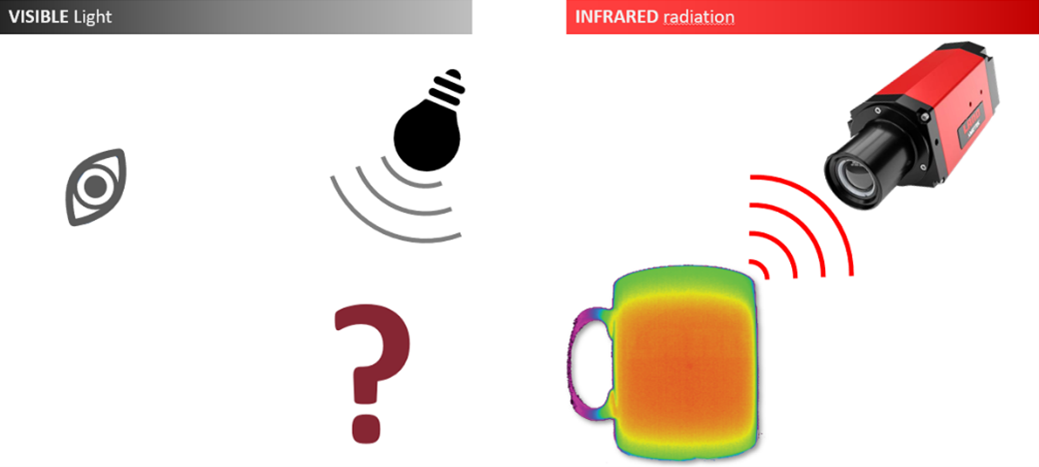Within many industries and applications, visible cameras are widely used for process monitoring. Even in security applications, visible cameras or special residual light amplifying cameras are used to retrieve accurate images even when there is poor lighting.

Fig.1: Comparing image of a visible and a thermal image in a steel plant
What these cameras have in common is, that they need ambient light, either from the sun or daylight or electric lights to give images which can then be monitored or captured.

Fig.2: In comparison visible camera need ambient light, thermal imagers do not
Infrared radiation – or infrared light is emitted from an object due to its temperature, material, and surface conditions. The hotter an object is, the higher the emitted radiation intensity is, mostly emitted in the infrared spectral range.

Fig.3: Planck’s Radiation Law – showing the emitted radiation of a black body at different temperatures and wavelengths
Further Planck’s Radiation Law shows that with increasing temperatures, the spectrum of emitted radiation shifts towards shorter wavelengths (visible colours). This results into ‘glowing colours’ in the visible light, when object temperatures get higher than approximately 600°C.
Fig.4 shows a steel bar exiting a continuous horizontal caster while cooling down. However, if temperatures are lower than approximately 550°C no lowing colours are “visible”, but objects can still be extremely hot
. 
Fig.4: Glowing colours representing different temperatures at a horizontal con-caster
While talking about “visible light”, different colours do have different wavelengths, for example, deep blue is around 400 nm and deep red is around 700 nm. These are the colours a human eye can see and are the main colours that a visible camera will detect, with a slightly extended range at the longer wavelengths side. Typically, visible cameras include an IR filter to cut out any image disturbing infrared radiation to the image quality.

Fig.6: Steel ladle visible image vs. thermal image
If you look at Fig.6, you can see a visible camera can see the ladle itself, but it does not detect its different emitted radiation intensities in the infrared spectrum.
Visible cameras monitor objects as long as enough ambient light is available and give different contrasts and colours based on the object surface conditions.
Infrared imagers do not need any ambient light and detect the self-emitted infrared radiation of an object, based on its temperature, material and surface conditions.
While we are used to to seeing different colours in the visible light range, like red, blue, or yellow, with the infrared range, it is divided into different wavelength sections. The whole infrared range is 0,7 – 100 µm wavelength, while the "thermal infrared" range is 0,7 - 15µm and is mainly used for infrared non-contact temperature measurements. Fig.7 shows the different sections and their wavelengths in the infrared spectrum.

Fig.7: Infrared spectral range and sections
Thermal imagers “make temperatures visible”, the contrast of a thermal image is based on the intensity of detected infrared radiation – the radiation intensity or the radiation power, typically monitored in different isotherm colours (colours at the same temperature) – see Fig.8.

Fig.8: Thermal image of a rotary kiln with different isotherm colours
Thermal imagers also can make something visible, which is invisible in the visible light, or they can exclude radiation which will make visible cameras unable to monitor a real image in certain applications such as hot furnace atmospheres, flames, or smoke. This is because different wavelengths are used with thermal imagers for different applications, “making the invisible visible”.
A flare stack at the top of an industrial stack, a liquid steel tapping stream or bath surface in the steel industry and many more applications are examples where the visible camera does not see real images.

Fig.9: Visible image vs. Thermal image in a flare stack monitoring application
Another example shows a visible image with lots of smoke and dust present, while the infrared thermal image shows a clear image in comparable smoke conditions – Fig.10.

Fig.10: Visible image with smoke present vs. thermal image showing a clear view
In summary, the most noticeable differences between visible and infrared cameras are:
- Thermal imagers are used for object and process monitoring and temperature measurement
- Thermal imagers do not need any ambient light to monitor an object and its temperatures
- Thermal imagers work at different spectral responses are able to give clear images and true temperature readings even when smoke or dust is present
- Thermal imagers can look through hot gas and flame atmospheres, like in heated furnaces
- Thermal imagers can make scenes visible, which are invisible in visible light
- Thermal imagers give absolute temperature readings at each camera pixel and show temperature distributions
Click here to learn about our thermal imaging products